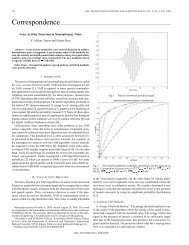Thesis (PDF) - Signal & Image Processing Lab
Thesis (PDF) - Signal & Image Processing Lab
Thesis (PDF) - Signal & Image Processing Lab
Create successful ePaper yourself
Turn your PDF publications into a flip-book with our unique Google optimized e-Paper software.
34 CHAPTER 2. THEORETICAL BACKGROUND<br />
x f(x) BTf(x) ˆπx [V(f)](x)<br />
0 0 0 (0) {0}<br />
1 -2 2 (0, −2) {−2}<br />
2 7 11 (0, −2, 7) {−2, 9}<br />
3 9 13 (0, −2, 7, 9) {−2, 11}<br />
4 11 15 (0, −2, 7, 9, 11) {−2, 13}<br />
5 10 16 (0, −2, 7, 9, 11, 10) {−2, 13, −1}<br />
(0, 3, 8, 5, 10) {8, −3, 5}<br />
6 5 11 (0, 3, 8, 5) {8, −3}<br />
7 8 8 (0, 3, 8) {8}<br />
8 3 3 (0, 3) {3}<br />
9 0 0 (0) {0}<br />
Table 2.1: The BTV transform of a 1-D function f. The boundary here are the<br />
first and last elements of the function. Notice that the point x = 5 is a skeleton (or<br />
watershed) point of the transform, with two different transform possibilities.<br />
pixels that are called skeleton pixels or watershed pixels.<br />
Table 2.1 presents a simple 1-D case for illustration.<br />
The plot of f(x) is given in Fig. 2.10.<br />
The original image f can be obtain back from Vf(x) as follows:<br />
f(x) = �<br />
Vf(x)i, (2.21)<br />
i<br />
where {Vf(x)i} are the elements of the alternating sequence Vf(x) = [V(f)](x). Equa-<br />
tion (2.21) represents the inverse BTV transform, V −1 .<br />
It is also simple to obtain the BTD function from V(f):<br />
BTf(x) = �<br />
|Vf(x)i| . (2.22)<br />
i<br />
For the example given in table 2.1, for x = 5, [V(f)](x = 5) is {−2, 13, −1} or<br />
{8, −3, 5}. For both variants of [V(f)](x = 5):<br />
f(x) = (−2) + 13 + (−1) = 8 + (−3) + 5 = 10,<br />
BTf(x) = | − 2| + |13| + | − 1| = |8| + | − 3| + |5| = 16.
















